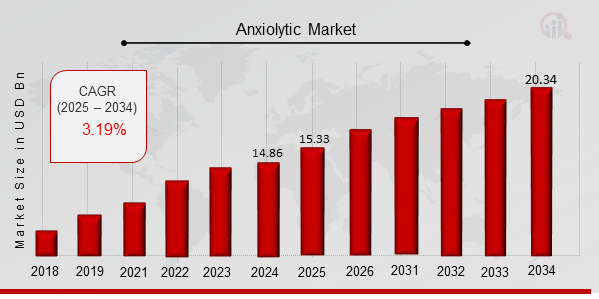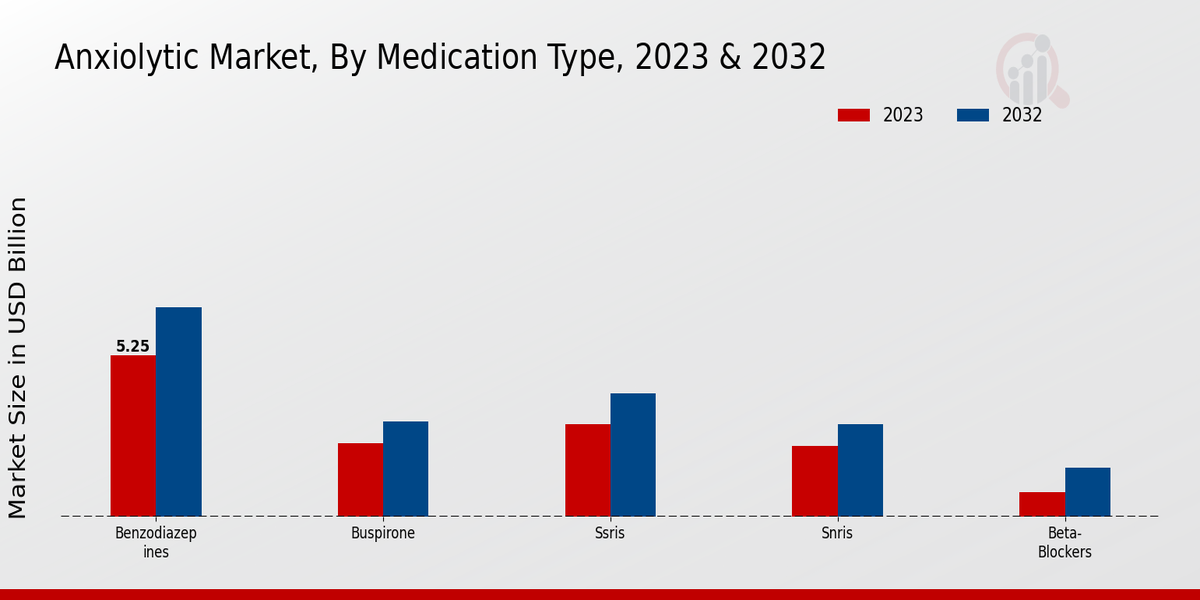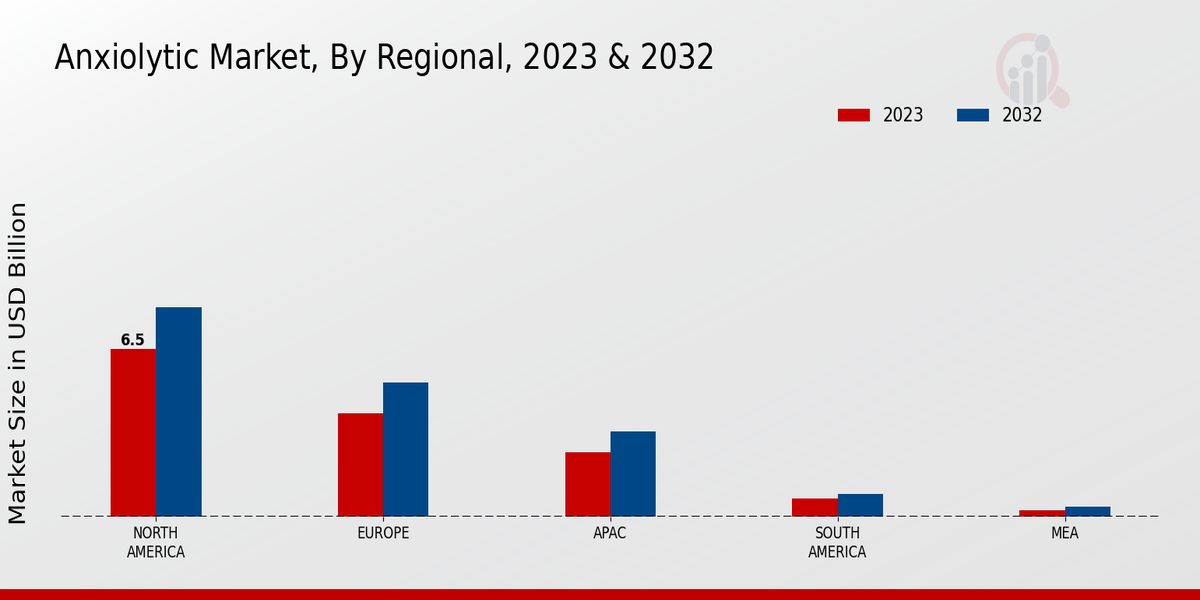Anxiolytic Market Overview
As per MRFR analysis, the Anxiolytic Market Size was estimated at 14.86 (USD Billion) in 2024. The Anxiolytic Market Industry is expected to grow from 15.33 (USD Billion) in 2025 to 20.34 (USD Billion) till 2034, at a CAGR (growth rate) is expected to be around 3.19% during the forecast period (2025 - 2034).
Key Anxiolytic Market Trends Highlighted
The Anxiolytic Market is helping extend mental health awareness on account of increasing demand for effective solutions in the treatment of various types of anxiety disorders including stress induced ones. This rising demand shall also lead to a major shift toward increasing both, pharmaceutical and non-pharmaceutical treatment solutions where the enhanced health systems globally are playing a supportive role. Furthermore, there has been an increased push towards acceptance of mental health therapies coupled with the notable rise in the aged populations that are more vulnerable to anxiety. These enormous possibilities in the Anxiolytic Market can be attributed to the increased advancement of novel treatment approaches along with targeted therapy.
With the increasing research on anxiety disorders, new formulations and a new delivery will evolve into satisfying the needs of the individual patient. One emerging area that needs to be explored is the integration of technology such as digital and mobile apps in the treatment of anxiety. Also, the increasing consumer interest in natural and holistic medicine opens up opportunities for the launch of a new product line too focused on these consumers. It is noted that there is a trend towards the use of telehealth services or online therapy applications that assist the patients suffering from anxiety. The COVID-19 pandemic has made mental illness a priority, generating an increasing demand for such services and products.
There is also a growing popularity of mindfulness techniques that are frequently combined with the use of anxiolytic medications, which allows for a more complex treatment. In summary, the trends of development of the Anxiolytic Market are aimed at making products more convenient, modern and individualized.

Source Primary Research, Secondary Research, MRFR Database and Analyst Review
Anxiolytic Market Drivers
Increasing Prevalence of Anxiety Disorders
The prevalence of anxiety disorders has seen a significant rise globally, driven by various factors such as increased stress, lifestyle changes, and the pressures of modern living. As more individuals turn to healthcare providers for help, the need for effective treatment options has surged, significantly boosting the growth of the Anxiolytic Market Industry. With anxiety disorders affecting millions, healthcare systems are prioritizing mental health, leading to increased recognition and diagnosis of anxiety-related conditions.This shift has prompted pharmaceutical companies to develop new and effective anxiolytic medications, further stimulating market expansion. Additionally, as awareness of mental health issues continues to grow, more individuals are seeking treatment for their anxiety, thereby increasing the demand for anxiolytic drugs. The direct correlation between heightened anxiety levels and the demand for treatment options presents a substantial opportunity for growth within the Anxiolytic Market Industry.As more patients are diagnosed and prescribed anxiolytics, the market is poised for continued expansion, reflecting the urgent need for innovative therapies that address the diverse symptoms and specific needs of individuals experiencing anxiety.
Growing Acceptance of Mental Health Treatment
The increasing acceptance of mental health treatment has been a significant driver of growth in the Anxiolytic Market Industry. With societal stigmas surrounding mental health issues diminishing, more people are willing to seek help for their anxiety disorders. This normalization leads to higher prescriptions of anxiolytic medications, contributing to the market's expansion. Education campaigns and government initiatives have played a pivotal role in promoting the importance of mental health, encouraging individuals to prioritize their psychological well-being.As mental health awareness continues to rise, the demand for effective anxiolytics will likely increase, presenting new opportunities in the market.
Advancements in Pharmaceutical Research
Technological advancements and research in pharmaceuticals are significantly influencing the Anxiolytic Market Industry's growth. The development of novel anxiolytic compounds that offer improved efficacy and fewer side effects has created a competitive edge for companies in the market. Initiatives to explore alternative treatment methods such as herbal formulations and non-traditional therapies are also gaining traction, which broadens the options available for patients.Continuous investment in research and development consequently fosters innovation in the sector, meeting the evolving needs of patients with anxiety disorders.
Anxiolytic Market Segment Insights
Anxiolytic Market Medication Type Insights
The Anxiolytic Market is increasingly segmented by Medication Type, showcasing a diverse range of therapeutic options catering to anxiety disorders. In 2023, the market value for this segment reached approximately 13.95 USD Billion, with several medication classes displaying varying degrees of prevalence and acceptance among healthcare providers and patients. The Benzodiazepines category holds a dominant position in this market with a valuation of 5.25 USD Billion in 2023, demonstrating the widespread use and trust in their efficacy for immediate anxiety relief, thereby representing a majority holding within the total market.
Following closely is the SSRIs segment, valued at 3.0 USD Billion, which has gained substantial traction due to its favorable side effect profile and effectiveness in treating generalized anxiety disorder, thus solidifying its significant role in the treatment landscape. Buspirone, valued at 2.4 USD Billion, offers a unique therapeutic alternative as it is non-addictive and is favored for chronic anxiety management, reflecting a notable growth in preference among specific patient demographics seeking limited risk of dependency.
Also worth mentioning is the SNRIs category, valued at 2.3 USD Billion, which has carved a niche in off-label prescriptions for anxiety, further optimizing patient outcomes with its dual mechanism of action. On the smaller end of the scale, the Beta-blockers segment, though less dominant at 0.8 USD Billion, serves a critical role in addressing performance anxiety, demonstrating the varied application of anxiolytic medications beyond conventional use.The growing recognition of mental health has played a vital role in the overall market growth, driving innovations in formulations and expanding treatment indications.
However, challenges such as potential side effects and dependency issues with certain medications remain. Opportunities exist for expanding treatment guidelines and developing novel anxiolytic agents, which could enhance market dynamics and patient outcomes. The comprehensive understanding of the Anxiolytic Market segmentation by Medication Type illustrates how these medications collectively contribute to addressing anxiety disorders and highlights the ongoing evolution and adaptation within the industry to meet changing patient needs.

Source Primary Research, Secondary Research, MRFR Database and Analyst Review
Anxiolytic Market Route of Administration Insights
The Anxiolytic Market, valued at 13.95 billion USD in 2023, encompasses various routes of administration which are crucial for effective medication delivery. The segmentation of this market includes Oral, Intravenous, Intramuscular, and Sublingual routes, each holding its unique significance in treatment protocols. Oral administration is widely favored due to its convenience and patient compliance, forming a major part of the market growth dynamics. Intravenous routes are important in acute care situations where rapid action is necessary.Intramuscular administration is often used for medications requiring gradual absorption, while Sublingual administration allows for quicker onset of effects, making it an increasingly popular choice among patients.
The diversity in these routes highlights the adaptability of anxiolytic treatments to suit various patient needs and conditions. With continued innovation in drug formulations and delivery systems, there are significant opportunities for growth within the Anxiolytic Market, fostering advancements that cater to both healthcare providers and patients.Current trends indicate increasing patient demand for accessible treatment options, driving up overall market engagement and highlighting evolving patient preferences in treatment administration.
Anxiolytic Market Distribution Channel Insights
The Distribution Channel segment of the Anxiolytic Market reflects a vital structure in delivering anxiolytic medications to patients efficiently. As of 2023, the overall market is valued at 13.95 USD billion, showing robust activity driven by demand across various channels. Hospital pharmacies play a crucial role in this segment, providing immediate access to treatments for inpatients and specialized care regimes.
Retail pharmacies significantly contribute to market accessibility, allowing consumers to easily acquire medications without prescriptions.The emergence of online pharmacies has transformed patient access to anxiolytics, offering convenience and discretion, which is particularly appealing in today's fast-paced society.
Clinics continue to be essential distribution points, facilitating patient care through direct consultations and tailored prescriptions. The growth of e-commerce and telehealth services offers new opportunities and changing dynamics within the market's distribution landscape. Additionally, the importance of maintaining an omnichannel approach ensures that patients have multiple avenues to obtain essential medications while enhancing overall patient engagement with the treatment process.The Anxiolytic Market data suggests that each distribution channel plays a significant role in shaping patient access and market growth, contributing to the evolving landscape of the anxiolytic industry.
Anxiolytic Market Patient Demographics Insights
The Anxiolytic Market is poised for notable growth, with specific focus on Patient Demographics such as Adults, Elderly, and Children. In 2023, the market reached a valuation of 13.95 USD billion, showcasing the increasing demand for anxiolytic treatments amidst rising anxiety disorders globally. Adults represent the largest segment due to high prevalence rates of anxiety-related conditions linked to stress and lifestyle factors. The Elderly demographic is also significant, as this group frequently faces anxiety related to age-related issues, requiring tailored therapeutic approaches.
Moreover, Children represent a growing focus within the market, as awareness of pediatric anxiety increases, necessitating more effective treatments designed for younger populations. Overall, the Anxiolytic Market segmentation reflects the dynamic interplay between various patient groups, driven by factors such as rising awareness of mental health, evolving treatment options, and a growing emphasis on personalized care. However, challenges like regulatory hurdles and the stigma surrounding mental health treatment may impact market growth.Various opportunities lie ahead, particularly in developing innovative formulations and targeted therapies that address the unique needs of each demographic group, enhancing the overall Anxiolytic Market revenue.
Anxiolytic Market Regional Insights
The Anxiolytic Market is expected to grow significantly across various regions, with an overarching valuation of 13.95 USD Billion in 2023. North America leads this market with a valuation of 6.5 USD Billion, holding the majority share and reflecting the high demand for anxiolytic medications due to increased stress and anxiety levels in the population. Europe follows as a significant region, valued at 4.0 USD Billion, indicating strong healthcare infrastructure and awareness of mental health issues.
The APAC region, valued at 2.5 USD Billion, is emerging as a notable market, propelled by rising economic stability and growing acceptance of mental health care.South America, although smaller in value at 0.7 USD Billion, is witnessing increasing investments in healthcare, suggesting future growth potential. The Middle East and Africa (MEA) presents the smallest valuation of 0.25 USD Billion, yet the focus on mental health interventions is growing, signaling opportunities for expansion. The segmentation and overall Anxiolytic Market data reflect a diverse landscape characterized by varying levels of market development and different challenges across these regions, creating multiple opportunities for stakeholders.

Source Primary Research, Secondary Research, MRFR Database and Analyst Review
Anxiolytic Market Key Players and Competitive Insights
The Anxiolytic Market is characterized by a dynamic landscape where providers consistently innovate to meet the rising demand for mental health solutions. The competitive insights indicate a growing market driven by increased awareness and recognition of anxiety disorders. This burgeoning demand reflects societal shifts towards acknowledging mental health issues and the importance of addressing them adequately. Key players within this market operate in a highly regulated environment, with a focus on research and development as well as strategic collaborations to enhance their product portfolios.
The competition is intensified by the emergence of generic formulations and the evolving regulatory landscape, which necessitates adaptability and responsiveness from companies operating in this space.Sanofi stands out in the Anxiolytic Market due to its strong presence and commitment to developing effective treatments for anxiety and related disorders. The company leverages its extensive research capabilities and establishes footprint, allowing it to cater to diverse markets with a range of anxiolytic medications.
Sanofi's ability to integrate new technologies and research findings into its product development process underscores its strengths. The company's investment in clinical trials and collaboration with academic institutions enhances its reputation as a leader in the field. Sanofi’s strong brand recognition and dedication to patient-centric solutions further consolidates its position in the anxiolytic market, as it seeks to address unmet medical needs and improve the quality of life for individuals suffering from anxiety disorders.AstraZeneca has made a significant impact in the Anxiolytic Market through its innovative approach and robust drug development pipeline.
The company's focus on delivering breakthrough medications has positioned it as a key player in addressing anxiety-related ailments. AstraZeneca benefits from extensive research initiatives and a commitment to scientific advancement, ensuring that its anxiolytic offerings are both effective and safe for patients. The company's strategic partnerships and collaborations with healthcare providers enable it to extend its reach and effectiveness within the market. AstraZeneca's reputation for high-quality pharmaceuticals and its proactive engagement in mental health advocacy contributes to its credibility and authority in the anxiolytic segment, fostering trust among healthcare professionals and patients alike.
Key Companies in the Anxiolytic Market Include
- Sanofi
- AstraZeneca
- AbbVie
- Merck
- Teva Pharmaceutical
- Boehringer Ingelheim
- BristolMyers Squibb
- Forest Laboratories
- Roche
- Eli Lilly
- Johnsonand Johnson
- Pfizer
- Otsuka Pharmaceutical
- Novartis
- GlaxoSmithKline
Anxiolytic Market Industry Developments
Recent developments in the Anxiolytic Market have been notable, particularly as companies refine their strategies amid increasing competition and market demands. Sanofi has made strides in expanding its portfolio, focusing on the integration of novel drug formulations that cater to anxiety disorders. AstraZeneca is actively pursuing research collaborations to advance its anxiety treatment options. AbbVie and Merck have initiated clinical trials for new compounds aimed at enhancing efficacy while minimizing side effects. Teva Pharmaceutical continues to lead in generics, notably in anxiety medications, which reflects ongoing market growth in value to meet patient needs.
Boehringer Ingelheim and Bristol-Myers Squibb are also exploring mergers and strategic partnerships to bolster their presence in this therapeutic area. Recent reports indicate a merger between two pharmaceutical entities, enhancing production capabilities, though specific details are scarce. Roche and Eli Lilly are increasing investments in innovations that address mental health, contributing to a projected surge in the market valuation. Such growth indicates a robust demand for effective anxiolytic treatments, influencing the competitive landscape, with companies like Johnson and Johnson, Pfizer, Otsuka Pharmaceutical, Novartis, and GlaxoSmithKline pursuing initiatives to capture market share.
Anxiolytic Market Segmentation Insights
Anxiolytic Market Medication Type Outlook
- Benzodiazepines
- Buspirone
- SSRIs
- SNRIs
- Beta-blockers
Anxiolytic Market Route of Administration Outlook
- Oral
- Intravenous
- Intramuscular
- Sublingual
Anxiolytic Market Distribution Channel Outlook
- Hospital Pharmacy
- Retail Pharmacy
- Online Pharmacy
- Clinics
Anxiolytic Market Patient Demographics Outlook
Anxiolytic Market Regional Outlook
- North America
- Europe
- South America
- Asia Pacific
- Middle East and Africa
| Report Attribute/Metric |
Details |
|
Market Size 2024
|
14.86 (USD Billion)
|
|
Market Size 2025
|
15.33 (USD Billion)
|
|
Market Size 2034
|
20.34 (USD Billion)
|
|
Compound Annual Growth Rate (CAGR)
|
3.19 % (2025 - 2034)
|
|
Report Coverage
|
Revenue Forecast, Competitive Landscape, Growth Factors, and Trends
|
|
Base Year
|
2024
|
|
Market Forecast Period
|
2025 - 2034
|
|
Historical Data
|
2020 - 2024
|
| Market Forecast Units |
USD Billion |
| Key Companies Profiled |
Sanofi, AstraZeneca, AbbVie, Merck, Teva Pharmaceutical, Boehringer Ingelheim, BristolMyers Squibb, Forest Laboratories, Roche, Eli Lilly, Johnson and Johnson, Pfizer, Otsuka Pharmaceutical, Novartis, GlaxoSmithKline |
| Segments Covered |
Medication Type, Route of Administration, Distribution Channel, Patient Demographics, Regional |
| Key Market Opportunities |
Increasing prevalence of anxiety disorders, Growth of telemedicine and online therapy, Expansion of holistic treatment options, Rising awareness of mental health, Development of non-benzodiazepine alternatives |
| Key Market Dynamics |
Rising prevalence of anxiety disorders, Increasing geriatric population, Growing acceptance of mental health, Advancements in drug formulation, Expanding telehealth services |
| Countries Covered |
North America, Europe, APAC, South America, MEA |
Frequently Asked Questions (FAQ) :
The Anxiolytic Market is expected to be valued at 20.34 USD Billion by 2034.
The Anxiolytic Market is projected to grow at a CAGR of 3.19% from 2025 to 2034.
North America is forecasted to have the largest market value at 8.1 USD Billion by 2032.
Benzodiazepines are expected to have a market value of 6.8 USD Billion by 2032.
Buspirone is forecasted to hold the second-largest market share with a value of 3.1 USD Billion by 2032.
SSRIs are expected to be valued at 4.0 USD Billion in the Anxiolytic Market by 2032.
Key players in the Anxiolytic Market include Sanofi, AstraZeneca, AbbVie, Merck, and Teva Pharmaceutical.
Europe is expected to reach a market value of 5.2 USD Billion in the Anxiolytic Market by 2032.
The beta-blockers segment is anticipated to be valued at 1.6 USD Billion in the Anxiolytic Market by 2032.
Growth opportunities in the Anxiolytic Market include an increasing awareness of mental health and expanding treatment options.

















